“This post contains affiliate links, and I will be compensated if you make a purchase after clicking on my links.”
Last Updated on July 19, 2024
Expertly bred European and American Great Danes seem adequately equivalent. Considering that the Great Dane breed standards for both the European (Federation Cynologique International), and American Great Danes (American Kennel Club) are identical.
Fundamentally, the European and American Great Dane is the same breed of dog. For someone who knows the Great Dane breed well, the differences are easy to spot. But for those new to the breed, the distinction might not be that easily recognizable.
In this article, we’ll provide an in-depth comparison of the American and European Great Danes showing the disparity between both and how these differences came about.
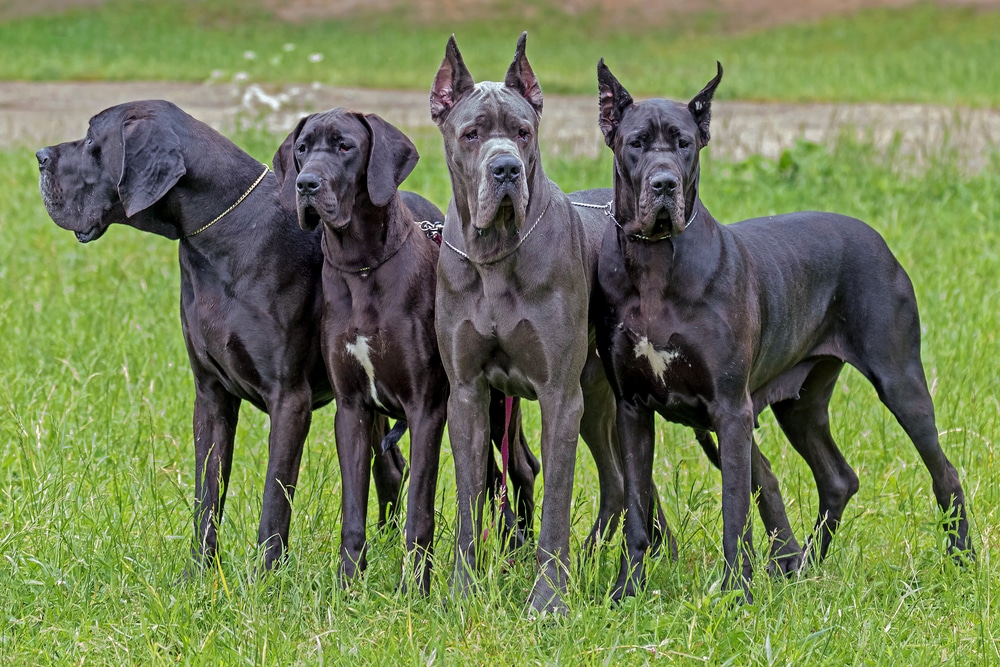
Get To Know The Breed
Now that you know that there are two types of Great Danes, you might be wondering how they came to be.
Actually, like other “purebred” dogs today, the Great Dane breed was actually “crossbreeds” a long time ago. They were created by combining different dog breeds to achieve another breed that has certain traits perfect for a certain purpose.
For the Great Dane breed, it is actually a mix of three different breeds, which are:
- Mastiff
- Greyhound
- Irish Wolfhound
Originally, Great Danes were bred for the purpose of hunting wild boars. Mastiffs have large muscles and are therefore incredibly strong, while Greyhounds are exceptionally fast and Irish Wolfhounds are huge. And with these above mentioned breeds mixed together, the perfect hunting dog was created.
Great Danes (both types) originated from Europe, specifically in Germany. And contrary to popular belief, they are not from Denmark.
Initially, Germans bred the Great Danes over 400 years ago. And Germans also created two types of the breed – one was slimmer in order to be able to climb steep regions. And the other one was heavier, meant for plain areas.
And because of this, breeders started labeling these two variations as American and European because of their obvious difference in many aspects.
The American Great Dane vs European Great Dane: Breed Differences
European and American Great Danes are separated based on their locality. The Great Danes that are exclusively bred in Europe today are labeled as European Great Danes. And those that are bred in the US are called the American Great Danes.
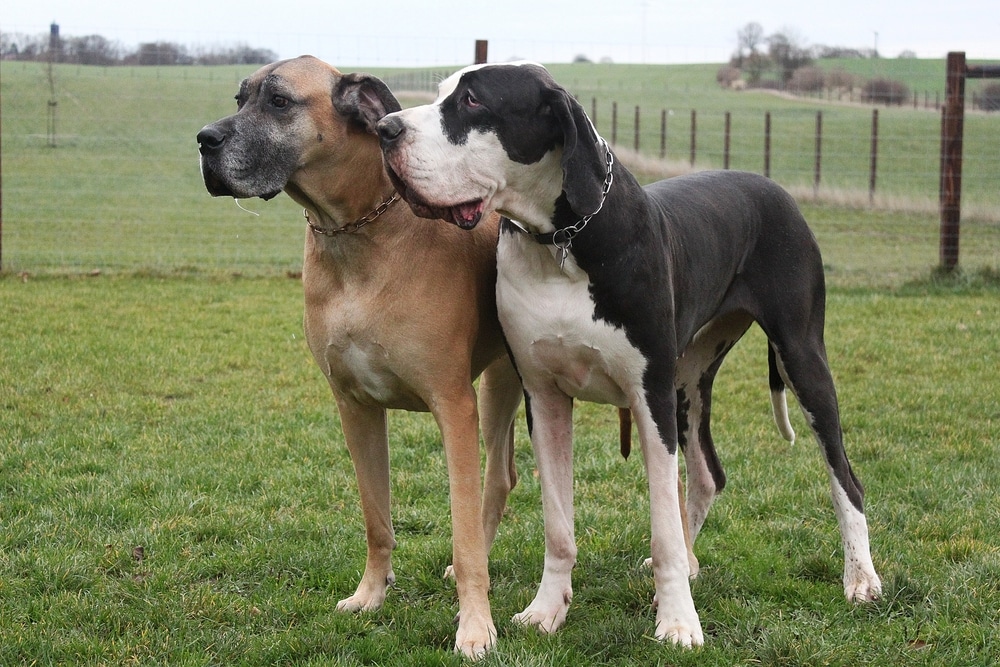
Although the differences between the two are not that big at first glance, most (if not all) of them are still noteworthy. Below, we list down these distinction to help you determine which is which.
1. Appearance
The appearance of both Great Danes is the first thing people notice when they see these dogs. And the major variations between them are as follows:
| European Great Danes | American Great Danes |
| A more Mastiff-looking appearance | A more sleek and Greyhound-looking appearance |
| A square-shaped head that looks big and heavy | Smaller and more rectangular heads |
| Droopy eyes and big hanging lips | A somewhat hanging lips (but not too extreme) |
| Thick neck | Slim neck |
With these differences, you’ll see that European Danes appear to be stronger and are still physically fit for the purpose of hunting. Meanwhile, the American counterpart appears lighter on their feet and looks way more adjusted as family pets and for professional dog shows.
2. Size and Weight
The size and weight of European and American Danes varies. But generally, the European counterpart is heavier and bigger, owing to their Mastiff-looking appearance.
Typically, European Great Danes will grow between 30 to 34 inches tall and can weigh anywhere from 180 to 240 lbs. Although their height is around the same as their American cousins, European Danes weigh more.
Meanwhile, American Great Danes will grow between 28 to 32 inches and can weigh anywhere around 100 to 200 lbs. They owe their lighter weight to their sleek and graceful appearance, as opposed to the bulkier appearance of their European counterpart.
3. Temperament
Surprisingly, there are obvious difference in both European and American Danes when it comes to their personality and temperament. This is, perhaps, their most noticeable distinction. Such distinction is the result of the genetic control breeders have made over the past years.
Let’s take a closer look at these dogs’ temperament below.
European Great Dane Temperament
European Danes are known to be affectionate and loyal dogs. They are a lot more docile than their American cousins, love their comfort zones and are considered lazy couch potatoes. However, they can still be a lot more active than American Danes. Since they are still mainly bred to hunt and work, their energy levels are higher.
And since they are still used as hunting and guard dogs, European Danes aren’t as friendly with strangers. It may take a while before they warm up to strangers.
When it comes to training European Danes, there’s one word you have to remember: consistency. If the training isn’t consistent, they will feel it and will refrain from following you and your commands.
American Great Dane Temperament
American Great Danes are more friendly than their European cousins. Since they are mainly bred to be family companions and show dogs, they can be very social towards others, whether it be with strangers or other dogs or pets. And for this reason, they are also often referred to as “gentle giants”.
And unlike European Great Danes, American Danes are not as active. They only need a moderate amount of exercise and because of this, they actually make good companions for apartment living.
Generally, American Danes are easy to train. Since they’re also known as people pleasers, they respond well to commands. And most of the time, positive reinforcement helps a lot during training.
4. Lifespan
It is general knowledge that Great Danes have short lifespans due to their size. And as with any canine breed, overall body mass directly affects the lifespan. So, the higher the dog’s body mass, the lower the life span will be.
Since there’s a considerable difference in both the American and European Danes’ body mass, the longevity of their life is different.
Lifespan of a European Great Dane
The European Great Danes hold shorter life spans as compared to American Great Danes. Usually, the Great Dane originating from Europe would die at 6 years of age. They might live up to 8 years old, if they’re fortunate enough.
Lifespan of an American Great Dane
An American Great Dane is reported to live longer. The American Dane’s life span could be between 9 to 10 years of age. And some Great Dane dog parents have claimed that their American Great Danes have lived up to 13 years old.
5. Ear Cropping
Great Dane ear cropping has a long history. Originally, Great Danes had their natural floppy ears cropped because they often get injured while hunting wild boars in Europe. But modern day ear cropping is now merely a personal and aesthetic preference among dog owners.
European Great Danes
Most European Great Danes have maintained their floppy, natural ears. This is because the ear cropping practice is prohibited in various European countries. Additionally, European Great Dane owners consider Great Dane ear cropping cruel and ruthless. Therefore, celebrated Great Dane show champions in Europe have natural ears.
American Great Danes
On the other hand, a lot of American Great Danes get their ears cropped. Great Dane ear cropping is more of a cult in America. Furthermore, American dog show champions almost always have their ears cropped and you’ll rarely see Great Danes with natural floppy ears competing for the title.
The practice is quite popular in the US. It is legal but must be performed under certain conditions and by a licensed veterinarian. That’s why it is not that frequent to find a Great Dane with natural floppy ears in the US.
Great Dane Breed Standards
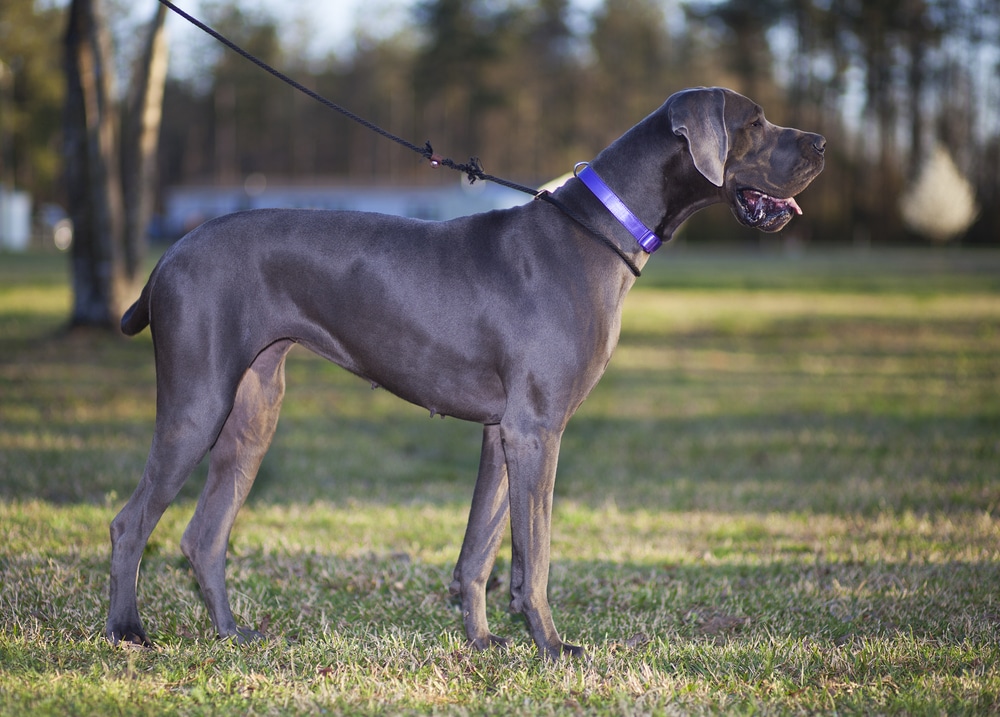
The Great Dane breed standards according to the American Kennel Club (AKC) and Federation Cynologique International (FCI) are set to protect this large canine breed from alterations. And to also ensure they are of high quality and health.
Even before the AKC and FCI, The First German Standard in 1891, clearly states:
“The Great Dane combines in its overall appearance size, power and elegance as in scarcely any other breed of dog. It does not have the heaviness and clumsiness of the Mastiff, nor the lankiness and light weight reminiscent of the Greyhound’s shape, but holds the middle ground between either extreme.“
Despite this, the breed standard of Great Danes existing in various parts of the world today depict somewhat sharp dissimilarities to Great Danes in the past.
Further elaboration of the Great Dane breed standard is done by the president of the Deutscher Doggen Club (DDC), Mr. Gügel. He is also the breeder of the famous Great Dane, Heiko von der Burg Thann, which was the designated model of excellence for the Club’s hundredth anniversary.
Mr. Gügel clealry explained (and translated to English by Ruth Stolzewski) on the standard publication of the Deutsche DoggeN Club 1888 e.V. in 2011:
“The (standard) of the Great Dane stayed the same in most of its parts, even if sometimes with different wording, especially the definition of the general appearance hasn’t changed. But if one compares the Champions of earlier times with the Champions of today, one can see obvious differences.
The bodies are bulkier today and the heads heavier. We haven’t paid enough attention to the angulations and the movement. So faults appeared which we don’t recognize anymore today. That’s something we have to change together: the officials of the clubs, the judges and the breeders. It is not our task to only manage the breed.”
He further propagated,
“We have to preserve and promote it and protect it from an over-interpretation of the standard. Expertise and sound judgment is therefore recommended. It was the goal of the founding of the E.U.D.D.C. Club in 1981 to join all friends of the Great Dane for a uniform interpretation of the standard. (…) Judged objectively we haven’t managed to achieve this goal in the last 25 years. Some countries still prefer very different phenotypes.”
Deviations from the Breed Standard
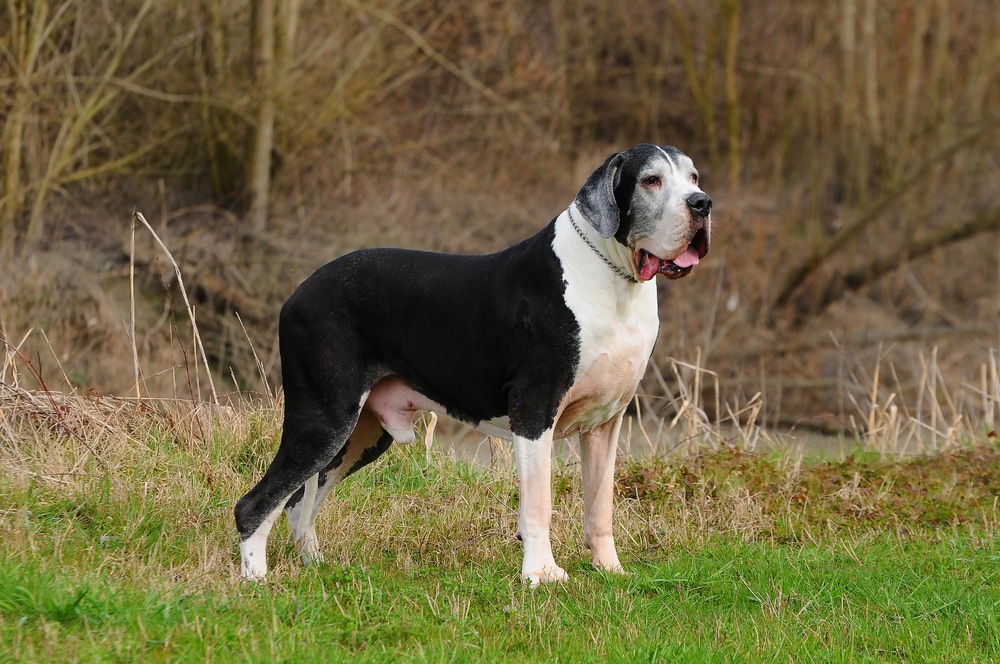
Both the European and American Great Danes can be seen deviating from the breed standards set by FCI and AKC. For instances:
- Almond eyes are a Great Dane breed standard. Yet both variation of Great Danes possess droopy eyes, which is regarded as a flaw.
- Standard Great Dane breed lips should not be hanging. Too much or very little lips do not comply with the breed’s standard. However, both variations have hanging lips, with the European Great Danes having a more prominent saggy lips than American Great Danes.
- Excessive skin is not a prerequisite for European or American Great Danes. But European Great Danes hold added skin as compared to American Great Danes.
European Great Dane Deviations
European Great Danes do not have an identical phenotype across Europe. For instance, in France, there’s a very different type of Dane that is accepted as the standard.
This trend is also common in Germany. Great Dane dogs that would not adhere to breed standards have been allowed to become champions, club champions, sires or given approval as popular sires. Although, at times, standard Great Dane dogs are still seen competing for those titles.
Other regions that got influenced by this drift in Great Dane breed standards are the South, East and South-Western European countries. They have bred Great Danes according to the cult towards the hyper-type.
These hyper-type Danes exhibit a clear shift and have a closer resemblance to Mastiffs. And Nordic countries, who have expertly maintained the FCI breed standards, strongly criticize these dogs. As hyper-types, in general, pose health concerns.
Furthermore, the breed clubs in other non-FCI– countries have managed to retain the Great Dane breed standard quite well for over a hundred years. For instance, in Britain, North America and Australia, such a vast breed variation is not prevalent.
American Great Dane Deviations
Today, you’ll see American Danes looking more like their European cousins. They’re going from the standard or American type to bulkier or semi-hyper European Danes. And this breeding deviation is actually something American Great Danes owners appreciate frequently.
Coveting or owning “Euro” Danes has become a trend in the US. This type of Great Dane is now welcome in dog shows. And even conformation judges also favor these hyper-type Danes.
And such dogs have even won in dog show categories that would’ve otherwise gone to a standard American Great Dane.
Health Issues Due to the Deviation from Breed Standards
Deviation from the breed standards can be dangerous. As briefly mentioned above, hyper-type are dangerous because they are more likely to develop a series of health issues.
Hyper-type Danes have a more-Mastiff looking head that are bigger than their bodies. And this can be dangerous as the dogs will struggle to carry the weight of their head.
Furthermore, since hyper-type Danes have droopy eyes, they are more likely to develop major eye problems like entropion and ectropion.
Keeping in view the public’s standpoint, in 2012, The FCI’s Standard Commission demanded a revision to the breed standard descriptions where health risks could become a potential consequence of the standard’s requisites. People had reacted very vehemently upon health problems of one or the other breed since the recent tenners.
Great Dane Breed Refinement
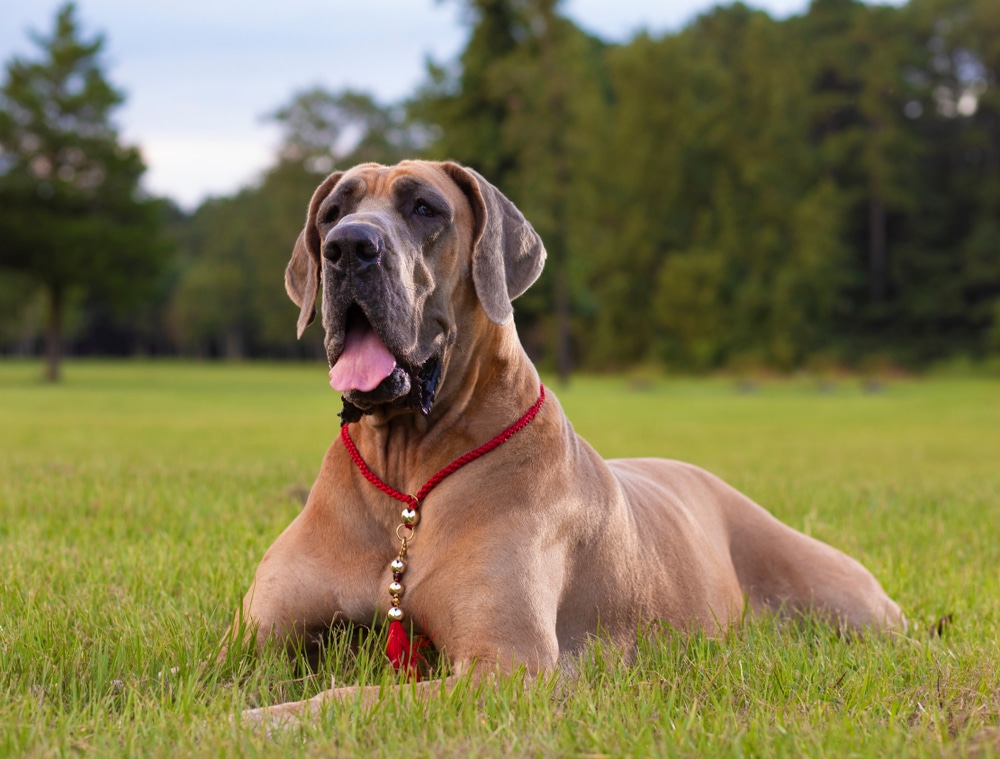
Breed standards are what makes Great Danes, or any canine breed in general, unique and distinguishable from other dogs. These standards are what gives the Great Dane breed their own unique identity and definite existence.
However, the general Great Dane breeding preference has been and still being continuously altered and refined. Breeders have become more inclined to achieve a “middle” Great Dane that is the perfect mix of the standard American Great Dane and European Great Dane.
Considering the breed’s deviation in Europe for the past thirty or forty years, it’s fair to say that creating a perfect mix of both American and European Danes hasn’t been successful.
Great Dane breeding trend is shifting altogether towards the hyper-type Great Dane. And European type Danes are gaining more and more popularity in recent years.
Refining a breed
Refining a breed is an arguable point. One can refine one dog for the purpose of substituting its flaws in the lineage. For instance, the dog’s performance (be stronger, faster, more active, etc.), its facial features, size, and anything that people might find that the particular dog might “lack”.
And with this “refinement”, you’ll have a dog that has favored characteristics but are beyond the breed’s standards, and in the long run, a dog that is completely different from what it’s supposed to look like.
Is the Breed Refinement Practical?
Through years of refinement, we’ve seen that this process is not practical nor helpful at all. Every step taken, no matter how big or small, to refine the breed has actually caused it to deviate from the standard Great Dane dog.
The farther the Great Dane breed has strayed away from the standard, the bigger the consequences are. The “refined” Great Danes we see today, as compared to the standard Great Danes, are lacking in so many important aspects – health, capability, temperament, and lifespan.
The so called refined, modern, natural and efficient Great Dane dogs are no more than a distortion and deviation of the breed standards. It was a result of the eagerness and vanity of people who were not keen in complying with the set breed standards.
Who is responsible for the Great Dane Breed Deviation?
The Great Dane breed is facing severe breed standard identity crisis. And a lot of entities are responsible for the breed’s major split into European and American Great Danes with numerous deviations.
These entities responsible for the deviation of the breed are:
1. Dog Breeders
It makes a lot of sense that dog breeders are largely responsible for such deviations. Many breeders purposefully alter the breed to cater to the public’s wants. People looking for Great Danes come from different places and want different things. And because of this, breeders cave in and breed Great Danes according to the buyers’ wishes.
Breeders ought to understand the big responsibility they bear. They need to realize the paramount significance they have in either altering or maintaining the breed standards.
However, given the breed’s identity crisis, it only means that more and more breeders are producing hyper-type Danes.
2. Dog shows and judges
Great Dane conformation dog shows and judges are, to some extent, also responsible for the Great Dane breed deviation. Instead of preserving the breed, some judges are supporting their vested interests.
They are leading the breeders and public’s interest to hyper-types. Since these Great Danes are being allowed to win as champions and are even suggested for breeding, people are more inclined to buy dogs that look similar to these hyper-type champions, regardless if they participate in shows or not.
Usually, dog show judges, who are recruited for the imperative purpose of evaluating the Great Dane dog standards, are generally specialists in the breed.
However, these judges impose their own preferences instead of actually evaluating the dogs according to the breed standards. So, now Hyper-types are welcome in dog shows and have won as champions.
3. Dog owners
More and more dog owners are looking for certain features in Great Danes that aren’t entirely characteristics of the breed. And with the rising demand from buyers, of course breeders will do everything they can to produce more of these Danes. And now, we’ve seen the changes in the breed’s appearance deviating away from breed standards because of this.
Furthermore, dog owners want to have “show-quality” Danes, regardless if they are up to standards or not, and are intent to win over the judges. There are dog owners who are more concerned about winning titles for their dogs and will do everything to achieve this, even if it means not adhering to the breed’s standards.
4. Breed clubs
There are many breed or kennel clubs that have different breed standards. They do not follow the same breed standards and some have slightly different rules. This confuses not only breeders or dog owners, but the public in general.
5. Administrations
Governments can also play a part by inducing pet protection laws. For instance, in Germany, a strong national law for the protection of pets exists. Neutering, spaying, declawing etc. are only allowed in case they are recommended by a veterinarian. Furthermore, ear cropping is also prohibited under “alteration of appearance”.
Does the American Great Danes and European Great Dane call for a split in two distinct breeds?
No. Rather than attempting to refine the Great Dane breed, we must strive to restore and maintain the Great Dane breed in its standard and pristine form.

We need to breed sound Great Dane dogs adhering to the standards. Only with this can we preserve the Great Dane dog breed for generations to come.
It would be exceedingly destructive to split Great Danes into different varieties. This would limit the genotype of the Great Dane breed and aggravate the breed’s health further.
Many developing Kennel organisations such as the Kennel Clubs in the Nordic countries, as well as the Scientific Commission of the FCI, which is the world federation of kennel clubs with 94 national members to date, suggested a rather different idea.
Instead of splitting these two, retaining related breeds and in-breed varieties like European and American Great Danes, as interlinked genetic pools, with open breeding between them, can build a promising future for the Great Dane breed.
We at GreatDaneK9 ought to share the intent of restoring and preserving the Great Dane breed in its standard form.
The “American Great Dane Puppy” pictured is not a Dane. It may be a mix, likely with lab, but definitely not a full Great Dane. This does not represent American Dane puppies at all and should be replaced with an accurate picture.
I have been debating getting an Euro Dane or an American dane for my home as a pet and protector . I am a 61 yr old widow and have the blessing of knowing 2 separate people who each breed one type. I would like to know what type would be best for me?
I would say to take into consideration the size.
Being 65, I wont be walking a dog however, I do have a back yard for playtime. Im looking for protection and companionship Do you think a GD is a good choice for me???
All dogs need to be walked for at least half an hour twice a day. If you cannot walk a dog you should reconsider if you can really give a dog an adequate life. Dogs live to be walked. They adore the different natural scents. They live to run off the lead and explore. Your playtime is not enough for a small dog. It would be cruel to have such a large and active dog as a Dane and not walk it.
I think if you get the Dane proper and early training, a dane would be a perfect companion.
We recently adopted a Great Dane boy. He’s approximately a year plus. He apparently “was lost “ most likely due to the fact he was heartworm positive. This guy has been an absolute blessing!! He has the best personality, is eager to please and is absolutely a lover.